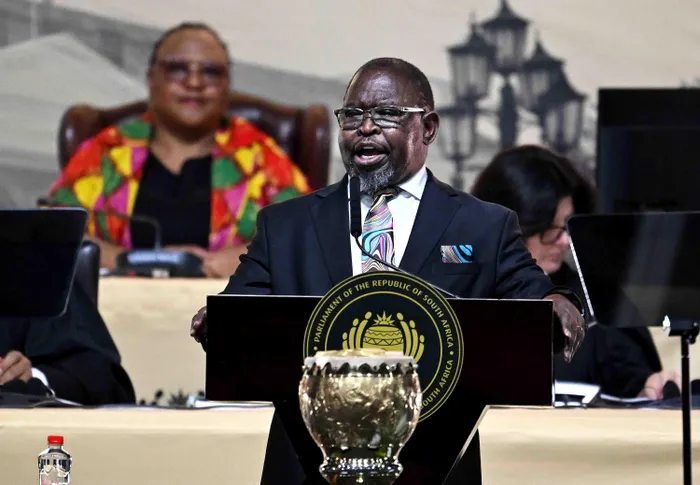S&P infers South Africa's debt levels could average 80% of GDP, surpassing estimates
CREDIT RATINGS

Finance Minister Enoch Godongwana will table the National Budget Review for the third attempt in Parliament on Wednesday after tensions within the Government of National Unity coalition over an increase in value-added tax (VAT) rates led to the budget being amended and re-tabled three times.
Image: File
S&P Global Ratings has warned that South Africa's general government debt could remain high, averaging an unprecedented 80% of gross domestic product (GDP) in the three years to 2028.
This would be much higher than the National Treasury’s estimate of an all-time high debt-to-GDP of 76.2% in the 2025/26 fiscal year.
Finance Minister Enoch Godongwana has noted the need to avoid a notable rise in borrowing projections, with 2025/6 likely at 76.4% of GDP, 2026/27 at 76.1%, 2027/28 75.9 and 2028/29 at 75.3%.
S&P on Friday, however, said public debt levels will remain elevated than expected given expenditure and revenue pressures, but said the government will continue its fiscal consolidation efforts.
"We expect general government debt, net of liquid assets, will average 80% of GDP in fiscal 2025-2028. This is slightly above government estimates, which forecast debt peaking at 76% of GDP in fiscal 2025 and then falling to 74% by fiscal 2028," S&P said.
"However, debt levels would be slightly higher without the government's tapping of the Gold and Foreign Exchange Contingency Reserve Account for R150 billion (2% of GDP) over fiscal 2024-2026. Debt servicing costs are a sizable fiscal burden. We expect interest costs will average 20% of government revenue over fiscal 2025-2028."
S&P also said that although general government debt stocks and refinancing needs remained sizable, deep domestic capital markets and increasing concessional financing from multilateral institutions (from a low base) provided adequate funding sources for the government.
Nevertheless, it said this remained lower than that of peers such as Brazil, Mexico, and Turkiye.
"We think banks can continue absorbing government debt. We expect foreign currency debt to increase modestly with potential Eurobond issuances and concessional financing from international financial institutions such as the World Bank and African Development Bank, but the bulk of fiscal financing will be undertaken in the domestic market," it said.
FNB economists on Friday said the government must still demonstrate a credible pathtowards fiscal consolidation in the face of these challenges.
However, they said there was a growing risk that the primary surplus, government’s key anchor for stabilising debt, will be under significant pressure.
"As a result, public debt may peak at a higher level than the 76.2% of GDP projected for 2025/26 in the 12 March budget," said FNB.
"Our current baseline view incorporates these risks and is reflected in our sovereign rating outlook, which suggests that an upgrade by S&P Global of South Africa’s local and foreign currency ratings to BB and BB+ may be delayed until next year."
The ratings agency on Friday maintained South Africa’s subinvestment status, affirming the country’s long term foreign and local currency debt ratings at ‘BB-’ and ‘BB’, respectively, with a positive outlook.
S&P said the positive outlook reflected the potential for stronger growth than it currently expected, despite trade- and tariff-related headwinds, alongside government debt consolidation, “if the coalition government can accelerate economic and fiscal reforms while addressing infrastructure pressures”.
It added that the ratings on South Africa benefited from the country's sizable and sophisticated financial system that provides a deep funding base for the government.
S&P said the country also has relatively strong institutions, with good checks and balances, particularly its central bank, the South African Reserve Bank.
However, the ratings were constrained by relatively low GDP per capita and low GDP growth rates, as well as sizable fiscal deficits and high government debt.
S&P lowered its economic growth forecast for South Africa while expressing cautious optimism regarding the country’s reform initiatives and efforts towards fiscal consolidation, even amid ongoing tensions within the coalition government.
S&P is now expecting South Africa's GDP growth to rise to an average of 1.5% over 2025-2028 after a subdued 0.6% in 2024, but cautioned that ongoing logistical bottlenecks and global tariff-related pressures will constrain economic activity.
“We expect real GDP growth to pick up slightly to 1.3% this year from 0.6% in fiscal 2024, as more private sector-driven electricity supply comes onstream, and last year's drought was not repeated. But growth will be limited by potential US tariffs and global tariff-related risks, both via direct and secondary effects such as slowing demand from China for key commodities,” it said.
Investec chief economist Annabel Bishop concurred on Friday that 2025 was likely to see GDP growth of 1.3% year-on-year now, revised down from 1.8% at the start of the year, while National Treasury forecast of 1.9% in March was likely to be revised down.
“The downwards revisions to growth, particularly for 2025 Treasury is likely to account for some of the likely very slight lift in the gross debt to GDP ratios but, stronger GDP growth, of 3.0%+ y/y, is needed for sustainable state finances,” Bishop said.
“The National Treasury having indicated it is planning a conservative, prudent budget, financial markets should not have a negative reaction, and nor should the credit rating agencies, although the latter will point to the constraint of weak growth.”
Visit: www.businessreport.co.za